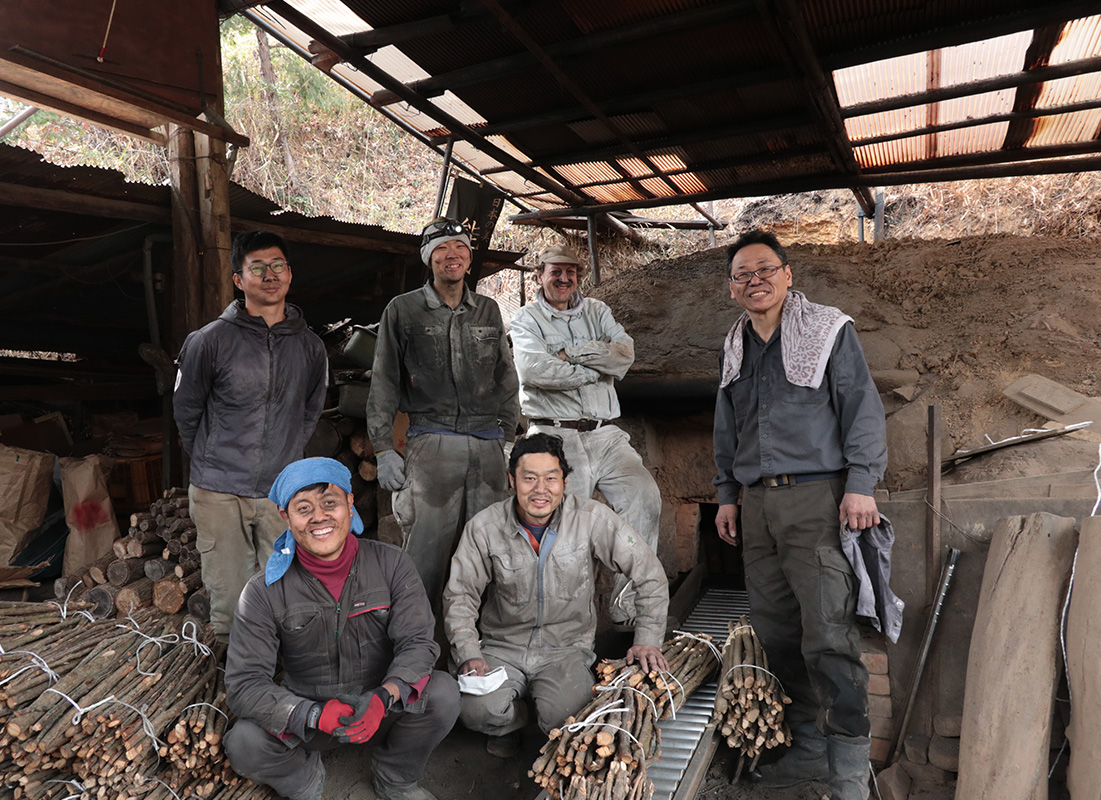For nearly five hundred years, tea masters, starting with Sen no Rikyu, have valued kikusumi (chrysanthemum charcoal) as “the charcoal for chanoyu.” This is why tea ceremony practitioners and charcoal makers have continued to work together in pursuit of creating the beautiful embers of kikusumi.
“Characteristics of high quality kikusumi.”
Kikusumi is produced using kunugi (the Asian oak species often referred to as “sawtooth oak”).
A cross-section cut reveals radiating cracks resembling chrysanthemum flowers. These crack lines need to be fine and evenly spaced.
The bark of the wood must be thin and tight around the core. Young branches used for charcoal should be smooth and resemble a “willow’s skin.”
When the charcoal is burning it will give off the fragrance of the kunugi tree.
When exhausted completely, the remaining ashes resemble a white chrysanthemum flower.
These aesthetic characteristics of kikusumi are not only sought after for its decorative value but are found to be “beautiful” as the result of innovations to charcoal for the purpose of attaining a functional and practical source of fuel. A core with finer and more numerous crack lines allows better air flow through the fuel and cleaner burning. Thin and tight bark skin prevents the charcoal from bursting when it burns. The gasses emitted from the kunugi that give off the pleasant fragrance, actually make the charcoal ignite quickly and burn efficiently.
Kikusumi has come into being out of a harmony between the careful work of charcoal makers and the refined sensibilities of tea masters. This wedding of “function” with “beauty” is what makes kikusumi an excellent fuel and, being so, a truly exquisite creation of the traditional crafts.

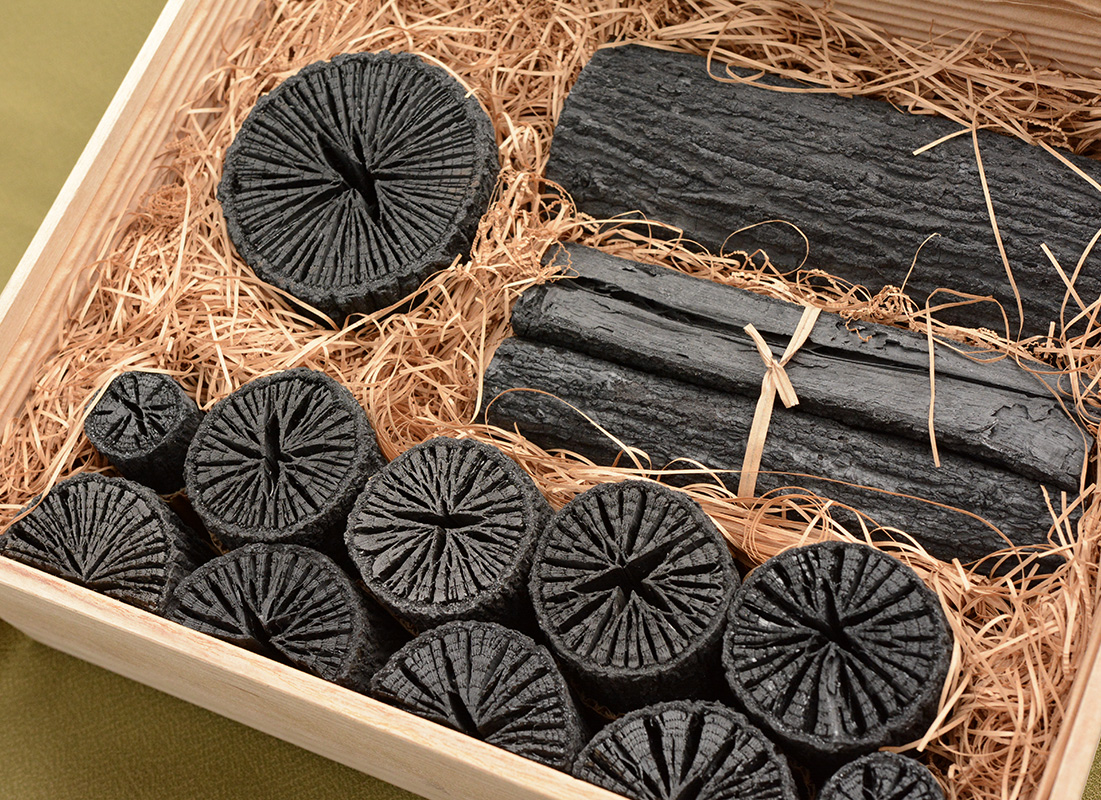
およそ500年前に千利休などの茶人たちに「茶の湯の湯炭」としての価値を見出された菊炭は、長きにわたり、茶人と炭焼き師たちの手によって、その美しさが追求されてきました。
一、切り口が菊の花のように放射状に割れており、割れ目が繊細で均一である
一、樹皮が薄く、密着しており、樹皮が柳肌のように滑らかである
一、燃焼したときに、ほのかにクヌギの香りがする
一、燃え尽きたあと、白い菊の花のような灰が残る
これら、美しい菊炭の条件は、なにも装飾性のみを追求したものではなく、実用性を洗練した結果、炭にもたらされた「美しさ」です。 割れが繊細なほど通気性があり燃えやすく、薄く密着した樹皮であるほど爆ぜにくい。 また、香りをもたらす原木由来のガス成分は、着火や燃焼を助けます。
こうした菊炭師の用途に対する誠実な手仕事と、茶人の洗練された審美眼が矛盾することなく調和した菊炭は、 燃料でありながらも、「用と美」が宿った民藝品といえるでしょう。
In a silent chashitsu, glowing embers ping and the fragrance of burning charcoal wafts through the room. Time passes and the sound of “breeze through pine trees” rises, telling those present the water in the iron pot has come to a boil. The host sets to work whisking the tea. When all the guests have partaken, the charcoal is now an ashen “white flower” on the hearth – the sole witness to a quiet communion.
Charcoal used in the hearth during chanoyu is not only chosen for its utility as an indoor fuel. It must also make a statement to the senses, especially sight, sound and aroma. During chanoyu, when one leaves mundane concerns aside, one is allowed a moment to reflect on the “impermanence” and “frailty” of the world. For that kikusumi is considered the ideal charcoal.
Although the charcoal used in chanoyu is now an important item along with vessels, implements and scroll paintings, it initially was not valued as it is today. When the practice of drinking tea was introduced to Japan, charcoal was considered nothing more than a “fuel” used to boil water indoors. It belonged in the “back” area and not something expressly shown.
This changed during the 16th century when the preparation of tea became an art performed “in front of the guest” and the development of the style emphasizing simplicity, called wabi-cha, by tea masters such as Takeno Jôô and Sen no Rikyu. They established the standard for charcoal that could be appreciated for its beauty, along with its positioning in the hearth and the way the charcoal was to be handled. The attention given to the aesthetic details continued until formal rules and manners of sumi-temae as it is practiced today were realized.
In the Kansai region Ikeda-sumi is famous and it is simply named so because it was sold at the market in the town of Ikeda located between rural mountain communities and the two urban centers of Kyoto and Osaka. The charcoal is actually produced on the foothills of Mount Myôken or the area known as Ikeda okuyama (deep mountain district of Ikeda). The charcoal made in the town of Nose, located at the northern corner of Osaka prefecture is specifically referred to as Nose kikusumi

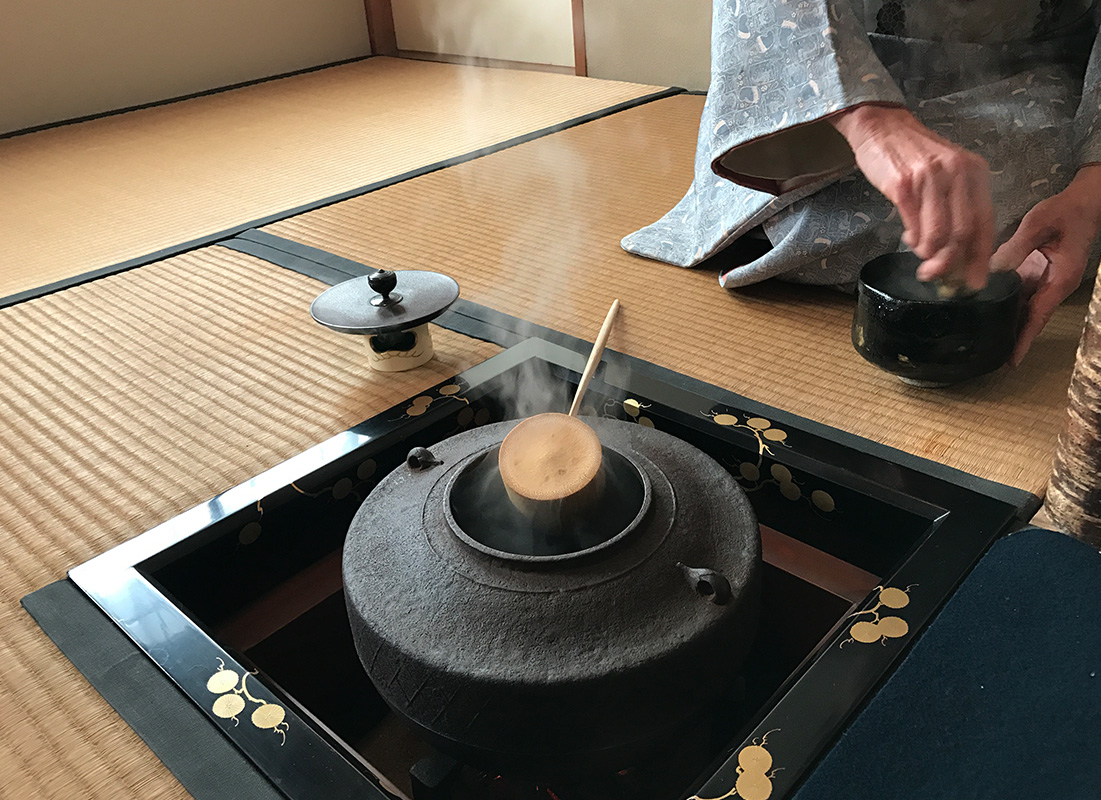
静かな茶室にピチピチと炭が燃える音が聞こえ、ほのかな炭の香りが漂う。やがて、釜の湯がわいたことを知らせる「松風の音」(松林がそよぐような音)が前景に浮き出すと、その報せを受けた亭主が茶を練る。茶席が終わる頃には炭は燃え尽き、灰となり、「白い花」を炉に残すーー
「茶の湯」の湯炭(茶釜にくべる炭)は、室内向けの燃料としてのみ評価されているのではありません。視覚、聴覚、嗅覚などの五感にも訴えかけ、外界と遮断された茶の湯の席に「うつろい」「はかなさ」といった風情を演出するゆえ、菊炭は「茶の湯には最高の炭」とされます。
今でこそ湯炭は茶器や掛け軸などと等しく、茶の湯にとって重要な道具のひとつですが、当初からそのような価値付けがされていたわけではありません。湯炭は、日本に喫茶の習慣がもたらされた頃から、室内で湯をわかすための「燃料」として必需品でしたが、いわゆる「裏」の部分であり、わざわざ見せるようなものではありませんでした。
それが「客人の面前で披露するもの」として捉えられたのは、武野紹鴎や千利休などの茶人が「侘(わび)茶」を確立した16世紀頃からだといわれています。鑑賞に耐えうるような美しい湯炭の基準ができ、炉への配置のしかた、炭を扱う時のふるまいまで、細部に渡って炭に関わる「美しさ」への研究を続け、その成果は「炭点前(炭手前)」という作法にまで結実します。
関西方面では「池田炭」として有名ですが、里山と都市の交易拠点だった池田市を通じて販売されていたためで、実際の生産現場は妙見山麗一帯の「池田奥山」です。 大阪府能勢町でつくる「能勢菊炭」も、そのうちのひとつです。
Winter arrives and leafless kunugi oaks stand dormant. It is time for charcoal makers to get to work. The silent mountains of Nose echo with the sound of chainsaws harvesting kunugi branches that are quickly prepared by practiced workmen.
The kunugi stands of Nose are particular for their rows of “canon batteries.” These strange looking trees are unlike other timber such as cryptomeria or cypress that are felled only once. Rather, they can be harvested over and over again. In respect to their dignified silhouettes they are called oyaji (father, or the more familiar “old man”), It is in these groves of oyaji where craftmanship and nature’s power cohabit, and the landscape they are part of bear witness to the spirit of charcoal making in Nose township.
Up along the mountain slopes, guardian oyaji gaze down on Nose. Let’s turn to a brief history of charcoal in this area and introduce the skills of its charcoal makers.

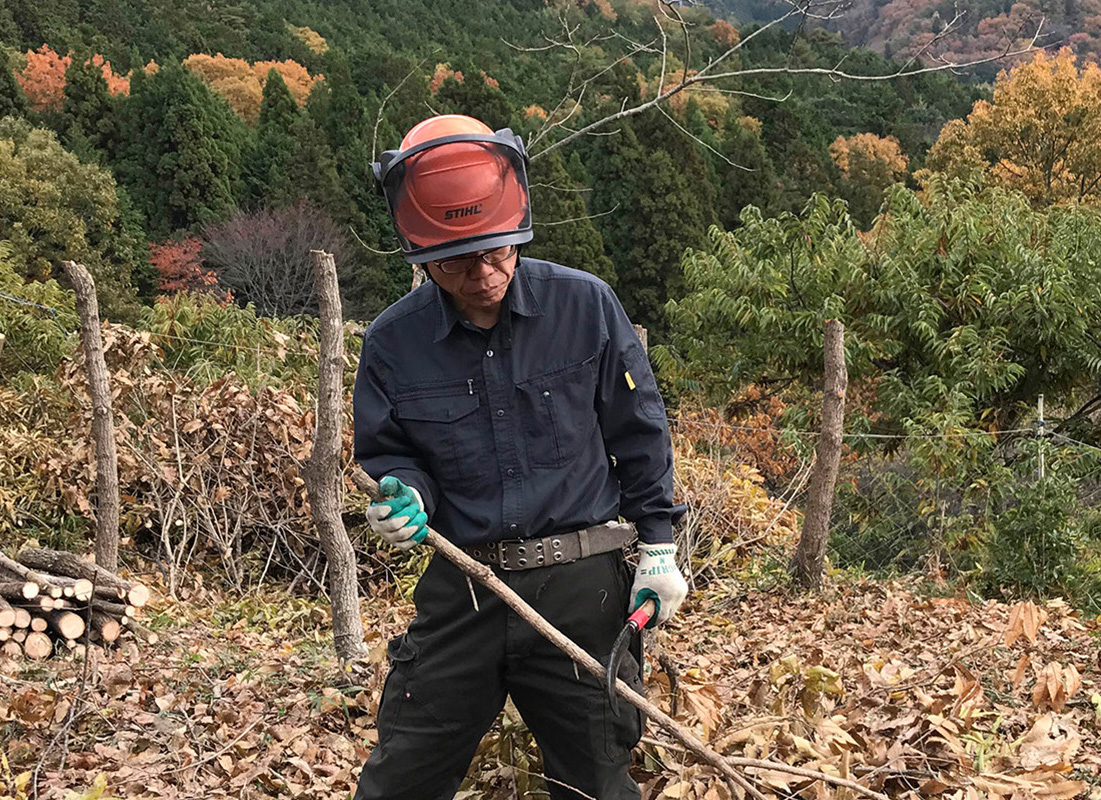
冬が訪れ、葉を落としたクヌギが眠りにつくと、炭焼きの仕事が本格化します。静かだった能勢の山にチェーンソーの音が響きだし、職人たちが手際よく、原木のクヌギを伐採していきます。
能勢のクヌギ山には「台場クヌギ」という独特の見た目をした木が並びます。自生の姿とはまったく異なるのは、スギやヒノキなどのように一度だけ伐採して終わりにするのではなく、木を活かしながら伐採を繰り返すからです。
その貫禄ある樹形からか、親しみと畏敬の念をこめて「オヤジ」とも呼ばれるそうです。「オヤジ」が並ぶクヌギ山は、人間の技術と自然の力が矛盾なく共存してきた証であり、能勢町の炭焼きを象徴するかのような風景です。
山の斜面に並ぶ「オヤジ」たちが見守る能勢町。ここでは、町内の炭焼きの歴史や、そこで育まれた炭焼師の技を紹介します。
In December the cutting and preparing of raw kunugi begins and it lasts until April when the yamazakura wild cherry trees bloom. This is when the leafless kunugi are dormant and their branches do not contain any extra moisture; the ideal condition for making charcoal.
These green logs are then fired in a clay earth kiln. It takes about fourteen days for the logs to become charcoal.
The most grueling work is loading the kiln. After the previous lot of charcoal is taken out, the next load is put in before the kiln can cool. The temperature inside is between 80 – 100 C. In the dark with only the light of a headlamp, workers stand the logs on end, making sure they are tightly packed together. In the scorching kiln one can only stay for about twenty minutes. Carefully but quickly the work must be done. When one gets out to have a drink sweat evaporates and a cloud of steam rises off the body. This is repeated and for each firing of a big kiln about 3 tons of wood (over 1000 logs) are required.

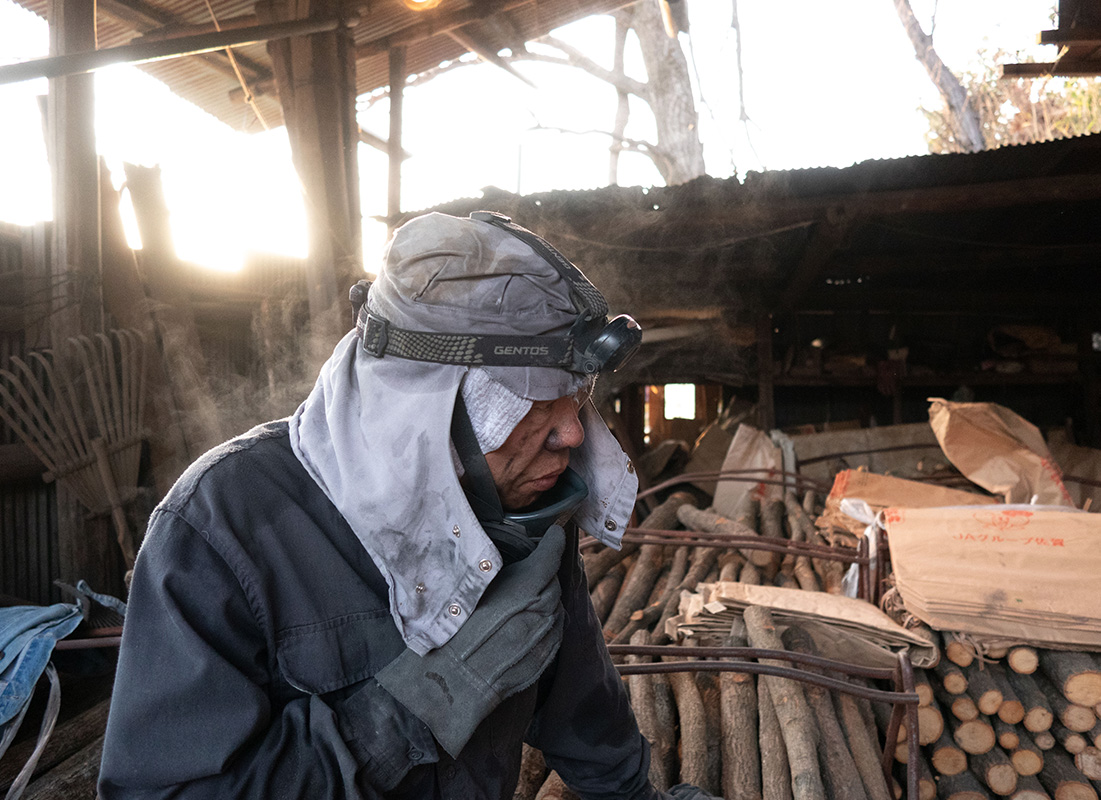
12月から始まる原木の調達は、翌年の4月頃、ヤマザクラが咲くまで続きます。この時期のクヌギは、落葉し、活動を休んでいる状態。休眠中のクヌギの枝には無駄な水分がなく、炭にするのに都合がよいのです。
採取した原木は、粘土でできた窯で焼きます。窯入れから炭出しまでにかかる日数はおよそ14日間。
中でも、窯入れはたいへん過酷な作業です。前作の炭を出してすぐ、窯が冷めやらぬうちに行なうので、窯の中は80〜100度。闇のなか、ヘッドライトの光だけを頼りにして、隙間ができないよう、ていねいに原木を敷き詰めていきます。灼熱の窯の中には20分ほどしか入っていられません。繊細かつ、手際よく行わないと、いつまでたっても終わりません。外に出て水分をとるとすぐさま汗が蒸発し、遠目にも見えるほどの湯気が身体から立ちのぼります。この作業を繰り返し、1回の炭焼きにつき、大きな窯ならおよそ3tもの原木(1000本以上)を立て込み、火をつけます。
The greatest skill required in making charcoal is knowing how to control the temperature and flames inside the kiln. If the temperature rises too fast, the bark will detach from the wood or the log will split. This spoils the beauty of the charcoal. Likewise, if the flames are smothered too soon the wood is not completely charred and when left too long only ash remains.
To “see” the heat inside a closed kiln, charcoal makers carefully observe the color of the smoke coming out of the small chimney. Right after the loaded kiln is fired the moisture filled smoke is white. As the temperature rises and carbonization progresses the smoke turns from black to purple and finally becomes a transparent gas.
When the temperature is negotiated with success from the time of firing, it takes about 14 days for a beautiful load of Nose kikusumi to appear out of the kiln.

炭焼きの技術の巧拙は、温度や燃え方を上手にコントロールできるかどうかで決まります。急激に温度が上がると樹皮が剥離したり、割れたりして、美しい炭にはなりませんし、火を止める際も、早すぎると生焼けに、遅すぎると灰になってしまいます。
職人たちは、目に見えない窯の温度を「みる」ために、煙突から上がる煙の色をよく観察し、ひとつの基準とします。窯焚き直後は水気を含んだ白い煙だったものが、窯の温度が上って原木の炭化が進むにつれ、黒色から紫色へ、そして、透明へと変化します。
温度の駆け引きがうまくいけば、火入れからおよそ14日後には美しい能勢菊炭が焼き上がります。
The border lands overlapping forested mountain foothills and cultivated village fields are referred to as satoyama. They are born from the work of human hands on nature and at times the response of nature to human endeavor. It is where human life and nature’s activity meet in harmony. The broadleaf forests of Nose have also been preserved by the effort of the people living under their shade. If these forests are untended and not given proper care, bamboo grass and bush will take over and prevent other plants from growing.
The same can be said about kunugi oak; these trees necessary for making Nose kikusumi. To allow these oaks enough time to recover and grow, their branches are only harvested once every 7-8 years. In order to harvest kunugi logs the forest underbrush is removed and the area is tended. It is this balanced cycle of human and natural activity that makes it possible for charcoal production to continue.
To make charcoal is in fact a way to preserve the satoyama. But, to pass on the tradition of Nose kikusumi it is necessary for the satoyama to be protected.

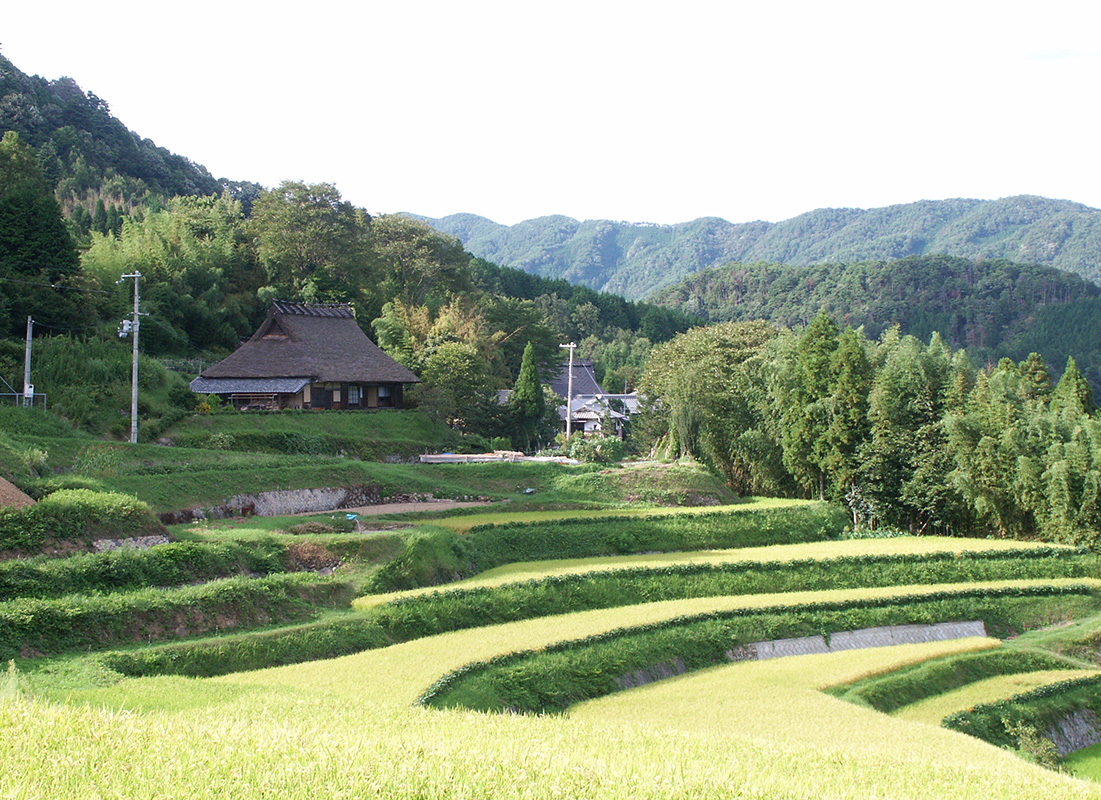
山と里の境界にある「里山」は、人が自然に働きかけ、時には働かき返されるなかでつくられてきました。いわば、人間の暮らしと、自然の営みが矛盾しない場所。能勢にあるような広葉樹の森も、人が働き続けることで昔のままの姿を保っています。野放しにしていてはササや低木に覆われ、他の植物が育ちにくい「放置林」となってしまいます。
能勢菊炭に欠かせないクヌギ山も同じです。クヌギが持つ再生力に合わせて7〜8年に1度だけ原木の切り出しす。放置林となってしまったクヌギ山から原木を切り出すために、整備する。人間の暮らしと自然の営みが矛盾しないようなサイクルがあってこそ、炭焼きの仕事が続けられます。
炭を焼くことは、里山を守ること。そして、能勢菊炭を後世に伝えることは、里山を守ることでもあるのです。
During the last half of his life, my father dedicated himself to making charcoal for the art of the tea ceremony. It seems he talked in detail about his work to other people, but was quiet about his feelings to us, his family. The words he left me with were this is a hard task, but it must be continued for posterity.
Employed locally by my town’s government office until the age of forty-four, I was involved in regional development; assisting in local events and the national sports competitions. With the help of our town’s people, we welcomed many people from neighboring cities to enjoy the rich heritage of our town. I was happy to see my effort result in creating many “Nose fans.” This drove me to work harder, sometimes forgetting to eat and sleep.
Through all of this I learned the importance of knowing my local region and nurturing its unique characteristics. And this quite naturally turned my eyes to the kikusumi my father was making. There were only a handful of charcoal makers in our surrounding area and most likely my father was one of the last.
The high quality of our charcoal is the result of the craft’s refinement in the natural medium of this region’s history and environment. As I learned more about kikusumi, it became clearer to me of how the Nose region had nurtured it to become such a prized commodity.

The act of chanoyu gives shape to the sentiments of thoughtfulness and caring held by the Japanese. It is in the space where the tea is prepared and served that for five centuries kikusumi has fueled the calm ambience and guided the flow of time.
To support the genuine form of chanoyu is in turn the foundation for the true sentiments residing in the hearts of the Japanese. To continue in the task set before us is to ultimately fulfill a great cause. For the last fifteen years, I have simply set my eyes on the distant goal and proceeded as if possessed.
I am like the relay runner passing this product of history the kikusumi of Nose on to the next generation. Recently, the number of like-minded companions has increased providing invaluable assistance. At present, we are concentrating our effort in nurturing the tree groves that provide quality wood and improving our management.
It is my desire for people outside of Japan to learn more about the high-quality and aesthetically appealing kikusumi that was born here in Japan. For this reason, we have started this global website.
Please take a good look at our kikusumi that we as Japanese are proud to offer to the world.
Yoshitaka KOTANI
Head Representative
The Nose Satoyama Creators LLC

父が晩年取組んだ茶の湯炭。他人には丁寧に語っていたようだが家族には無口な父だった。私にくれた一言「しんどい仕事やけど残さなあかん」。
私が44歳まで勤めた町役場では地域づくりやイベント開催、国体も担当した。町民とともに近隣都市部の人を迎え楽しんでもらう。能勢ファンを増やす。そんなテーマで食事も寝る暇もそっちのけで取り組んだ。
そして大切なことを学んだ。それは「地域を知ること」「地域の個性を大切にすること」。 ふと目にしたのが父が取組む「菊炭」だった。もう職人は府内では父を含み数人でおそらく父が最後になる。
歴史とその土地の環境、いわゆる風土が磨き上げた炭の傑作。菊炭のことを調べるうちに地域が育んできたたいそうな産物であることを知った。
日本人の心遣いを形にした「茶の湯」とともに場の空気をつくり時の移ろいを演出する燃料として500年の歴史を刻んできた「菊炭」。
本物の茶の湯を支えることは日本人の本物の心遣いを支える。目の前のことをやり続けることでその大義が成就する。私は何かにとりつかれたようにこの15年間前だけを見て歩いてきた。
私はこの歴史的生産地の菊炭を後世にバトンをつなぐランナー。ようやく伴奏してくれる仲間も増えてきた。今は良質な原木の育成と経営改善がテーマ。
日本が生んだ高性能であって美しい炭「菊炭」を世界へ発信し多くの人の評価を継続の力にしたいとグローバルサイトを開設した。 世界のみなさんへ日本のこだわりの「菊炭」をご覧ください。

